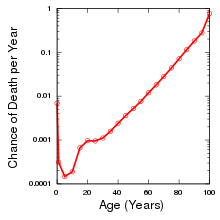This article relies largely or entirely on a single source. (May 2021) |

In gerontology, late-life mortality deceleration is the disputed theory that hazard rate increases at a decreasing rate in late life rather than increasing exponentially as in the Gompertz law.
Late-life mortality deceleration is a well-established phenomenon in insects,[1] which often spend much of their lives in a constant hazard rate region, but it is much more controversial in mammals.[2] Rodent studies have found varying conclusions, with some finding short-term periods of mortality deceleration in mice, others not finding such. Baboon studies show no mortality deceleration.
An analogous deceleration occurs in the failure rate of manufactured products; this analogy is elaborated in the reliability theory of aging and longevity.[1][3]
Late-life mortality deceleration was first proposed as occurring in human aging in Gompertz (1825) (which also introduced the Gompertz law), and observed as occurring in humans in Greenwood & Irwin (1939), and has since become one of the pillars of the biodemography of human longevity – see history; here "late life" is typically "after 85 years of age". However, a recent paper, Gavrilov & Gavrilova (2011), concludes that mortality deceleration is negligible up to the age of 106 in the population studied (beyond this point, reliable data were unavailable) and that the Gompertz law is a good fit, with previous observations of deceleration being spurious, with various causes, including bad data and methodological problems – see criticism.
According to a 2018 paper, statistical errors are the main cause of apparent mortality deceleration in humans.[4]
- ^ a b Gavrilov & Gavrilova 2011, p. 434.
- ^ Gavrilov & Gavrilova 2011, pp. 433–434.
- ^ Economos 1979.
- ^ Newman, Saul Justin (2018). "Errors as a primary cause of late-life mortality deceleration and plateaus". PLOS Biology. 16 (12): e2006776. doi:10.1371/journal.pbio.2006776. ISSN 1545-7885. PMC 6301557. PMID 30571676.